NCERT Solutions for Exercise 8.2 Class 12 Maths Chapter 8 - Application of Integrals
CBSE Class 12th Exam Date:01 Jan' 26 - 14 Feb' 26
NCERT Solutions For Class 12 Maths Chapter 8 Exercise 8.2
NCERT Solutions for Exercise 8.2 Class 12 Maths Chapter 8 Application of Integrals are discussed here. These NCERT solutions are created by subject matter expert at Careers360 considering the latest syllabus and pattern of CBSE 2023-24. NCERT solutions for Class 12 Maths chapter 8 exercise 8.2 is similar to the exercise 8.1. Also it has linkages with the previous chapter. Exercise 8.2 Class 12 Maths consists of questions related to areas bounded by two different curves. NCERT solutions for Class 12 Maths chapter 8 exercise 8.2 can be solved easily if the concept is understood from initial few questions. All other questions have the same concept used. Similar questions which are in this exercise are asked in Physics also, hence this exercise becomes more important.
12th class Maths exercise 8.2 answers are designed as per the students demand covering comprehensive, step by step solutions of every problem. Practice these questions and answers to command the concepts, boost confidence and in depth understanding of concepts. Students can find all exercise together using the link provided below.
Access NCERT Solutions for Class 12 Maths Chapter 8 Exercise 8.2
Application of Integrals Class 12 Chapter 8 Exercise: 8.2
Question: 1 Find the area of the circle $\small 4x^2+4y^2=9$ which is interior to the parabola $\small x^2=4y$ .
Answer:
The area bounded by the circle $\small 4x^2+4y^2=9$ and the parabola $\small x^2=4y$ . 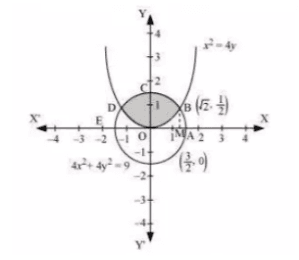
![]()
By solving the equation we get the intersecting point $D(-\sqrt{2},\frac{1}{2})$ and $B(\sqrt{2},\frac{1}{2})$
So, the required area (OBCDO)=2 times the area of (OBCO)
Draw a normal on the x-axis (M = $\sqrt{2},0$ )
Thus the area of OBCO = Area of OMBCO - Area of OMBO
$\\\int_{0}^{\sqrt{2}}\sqrt{\frac{(9-4x^2)}{4}}dx-\int_{0}^{\sqrt{2}}{\frac{x^2}{4}}dx\\ =\frac{1}{2}\int_{0}^{\sqrt{2}}\sqrt{9-4x^2}-\frac{1}{4}\int_{0}^{\sqrt{2}}x^2dx\\ =\frac{1}{4}[x\sqrt{9-4x^2}+\frac{9}{2}\sin^{-1}\frac{2x}{3}]_0^{\sqrt{2}}-\frac{1}{4}[\frac{x^3}{3}]_0^{\sqrt{2}}\\ =\frac{1}{4}[\sqrt{2}+\frac{9}{8}\sin^{-1}\frac{2\sqrt{2}}{3}]-\frac{1}{12}(\sqrt{2})^3\\ =\frac{\sqrt{2}}{12}+\frac{9}{8}\sin^{-1}\frac{2\sqrt{2}}{3}\\ =\frac{1}{2}(\frac{\sqrt{2}}{6}+\frac{9}{4}\sin^{-1}\frac{2\sqrt{2}}{3})$
S0, total area =
$\\=2\times \frac{1}{2}(\frac{\sqrt{2}}{6}+\frac{9}{4}\sin^{-1}\frac{2\sqrt{2}}{3})\\ =\frac{\sqrt{2}}{6}+\frac{9}{4}\sin^{-1}\frac{2\sqrt{2}}{3}$
Question:2 Find the area bounded by curves $\small (x-1)^2+y^2=1$ and $\small x^2+y^2=1$ .
Answer:
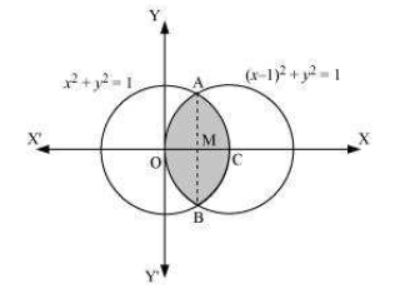 Given curves are $\small (x-1)^2+y^2=1$ and $\small x^2+y^2=1$
Given curves are $\small (x-1)^2+y^2=1$ and $\small x^2+y^2=1$
Point of intersection of these two curves are
$A = \left ( \frac{1}{2},\frac{\sqrt3}{2} \right )$ and $B = \left ( \frac{1}{2},-\frac{\sqrt3}{2} \right )$
We can clearly see that the required area is symmetrical about the x-axis
Therefore,
Area of OBCAO = 2 $\times$ Area of OCAO
Now, join AB such that it intersects the x-axis at M and AM is perpendicular to OC
Coordinates of M = $\left ( \frac{1}{2},0 \right )$
Now,
Area OCAO = Area OMAO + Area CMAC
$=\left [ \int_{0}^{\frac{1}{2}}\sqrt{1-(x-1)^2}dx +\int_{\frac{1}{2}}^{1}\sqrt{1-x^2}dx \right ]$
$=\left [ \frac{x-1}{2}\sqrt{1-(x-1)^2}+\frac{1}{2}\sin^{-1}(x-1) \right ]_{0}^{\frac{1}{2}}+\left [ \frac{x}{2}+\frac{1}{2}\sin^{-1}x \right ]_{\frac{1}{2}}^{1}$
$=\left [- \frac{1}{4}\sqrt{1-(-\frac{1}{2})^2}+\frac{1}{2}\sin^{-1}(\frac{1}{2}-1)-0-\frac{1}{2}\sin^{-1}(-1) \right ]+\left [ 0+\frac{1}{2}\sin^{-1}(1)- \frac{1}{4}\sqrt{1-\left ( \frac{1}{2} \right )^2}-\frac{1}{2}\sin^{-1}\left ( \frac{1}{2} \right )\right ]$
$=\left [ -\frac{\sqrt3}{8}+\frac{1}{2}\left ( -\frac{\pi}{6} \right )-\frac{1}{2}\left ( -\frac{\pi}{2} \right ) \right ]+\left [ \frac{1}{2}\left ( \frac{\pi}{2} \right ) -\frac{\sqrt3}{8}-\frac{1}{2}\left ( \frac{\pi}{6} \right )\right ]$
$= \left [ -\frac{\sqrt3}{8}+\frac{\pi}{6} \right ]+\left [ \frac{\pi}{6}-\frac{\sqrt3}{8} \right ]$
$=2 \left [ -\frac{\sqrt3}{8}+\frac{\pi}{6} \right ]$
Now,
Area of OBCAO = 2 $\times$ Area of OCAO
$=2\times 2 \left [ -\frac{\sqrt3}{8}+\frac{\pi}{6} \right ]$
$=\frac{2\pi}{3}-\frac{\sqrt3}{2}$
Therefore, the answer is $\frac{2\pi}{3}-\frac{\sqrt3}{2}$
Question: 3 Find the area of the region bounded by the curves $\small y=x^2+2,y=x,x=0$ and $\small x=3$ .
Answer:
The area of the region bounded by the curves,
$\small y=x^2+2,y=x,x=0$ and $\small x=3$ is represented by the shaded area OCBAO as
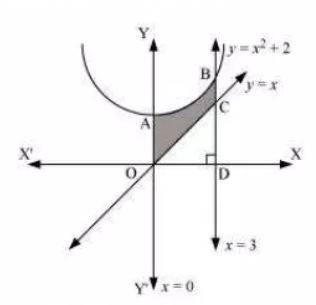
Then, Area OCBAO will be = Area of ODBAO - Area of ODCO
which is equal to
$\int_0^3(x^2+2)dx - \int_0^3x dx$
$= \left ( \frac{x^3}{3}+2x \right )_0^3 -\left ( \frac{x^3}{2} \right )_0^3$
$= \left [ 9+6 \right ] - \left [ \frac{9}{2} \right ] = 15-\frac{9}{2} = \frac{21}{2}units.$
Answer:
So, we draw BL and CM perpendicular to x-axis.
Then it can be observed in the following figure that,
$Area(\triangle ACB) = Area (ALBA)+Area(BLMCB) - Area (AMCA)$
We have the graph as follows:
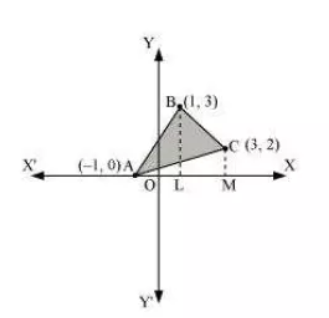
Equation of the line segment AB is:
$y-0 = \frac{3-0}{1+1}(x+1)$ or $y = \frac{3}{2}(x+1)$
Therefore we have Area of $ALBA$
$=\int_{-1}^1 \frac{3}{2}(x+1)dx =\frac{3}{2}\left [ \frac{x^2}{2}+x \right ]_{-1}^1$
$=\frac{3}{2}\left [ \frac{1}{2}+1-\frac{1}{2}+1 \right ] =3units.$
So, the equation of line segment BC is
$y-3 = \frac{2-3}{3-1}(x-1)$ or $y= \frac{1}{2}(-x+7)$
Therefore the area of BLMCB will be,
$=\int_1^3 \frac{1}{2}(-x+7)dx =\frac{1}{2}\left [ -\frac{x^2}{2}+7x \right ]_1^3$
$= \frac{1}{2}\left [ -\frac{9}{2}+21+\frac{1}{2}-7 \right ] =5units.$
Equation of the line segment AC is,
$y-0 = \frac{2-0}{3+1}(x+1)$ or $y = \frac{1}{2}(x+1)$
Therefore the area of AMCA will be,
$=\frac{1}{2}\int_{-1}^3 (x+1)dx =\frac{1}{2}\left [ \frac{x^2}{2}+x \right ]_{-1}^3$
$=\frac{1}{2}\left ( \frac{9}{2}+3-\frac{1}{2}+1 \right ) = 4units.$
Therefore, from equations (1), we get
The area of the triangle $\triangle ABC =3+5-4 =4units.$
Answer:
The equations of sides of the triangle are $y=2x+1, y =3x+1,\ and\ x=4$ .
ON solving these equations, we will get the vertices of the triangle as $A(0,1),B(4,13),\ and\ C(4,9)$
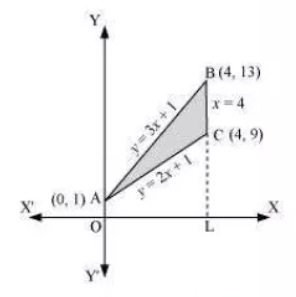
Thus it can be seen that,
$Area (\triangle ACB) = Area (OLBAO) -Area (OLCAO)$
$= \int_0^4 (3x+1)dx -\int_0^4(2x+1)dx$
$= \left [ \frac{3x^2}{2}+x \right ]_0^4 - \left [ \frac{2x^2}{2}+x \right ]_0^4$
$=(24+4) - (16+4) = 28-20 =8units.$
Question:6 Choose the correct answer.
Smaller area enclosed by the circle $\small x^2+y^2=4$ and the line $\small x+y=2$ is
(A) $\small 2(\pi -2)$ (B) $\small \pi -2$ (C) $\small 2\pi -1$ (D) $\small 2(\pi +2)$
Answer:
So, the smaller area enclosed by the circle, $x^2+y^2 =4$ , and the line, $x+y =2$ , is represented by the shaded area ACBA as
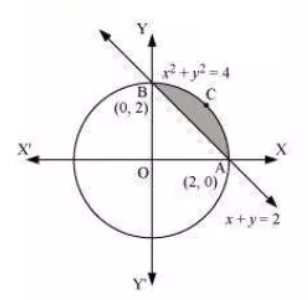
Thus it can be observed that,
Area of ACBA = Area OACBO - Area of $(\triangle OAB)$
$=\int_0^2 \sqrt{4-x^2} dx -\int_0^2 (2-x)dx$
$= \left ( \frac{x}{2}\sqrt{4-x^2}+\frac{4}{2}\sin^{-1}{\frac{x}{2}} \right )_0^2 - \left ( 2x -\frac{x^2}{2} \right )_0^2$
$= \left [ 2.\frac{\pi}{2} \right ] -[4-2]$
$= (\pi -2) units.$
Thus, the correct answer is B.
Question:7 Choose the correct answer.
Area lying between the curves $\small y^2=4x$ and $\small y=2x$ is
(A) $\small \frac{2}{3}$ (B) $\small \frac{1}{3}$ (C) $\small \frac{1}{4}$ (D) $\small \frac{3}{4}$
Answer:
The area lying between the curve, $\small y^2=4x$ and $\small y=2x$ is represented by the shaded area OBAO as
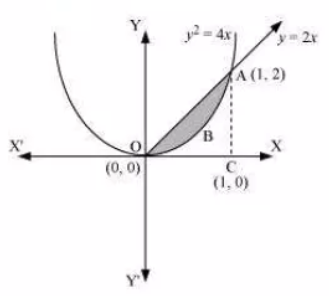
The points of intersection of these curves are $O(0,0)$ and $A (1,2)$ .
So, we draw AC perpendicular to x-axis such that the coordinates of C are (1,0).
Therefore the Area OBAO = $Area(\triangle OCA) -Area (OCABO)$
$=2\left [ \frac{x^2}{2} \right ]_0^1 - 2\left [ \frac{x^{\frac{3}{2}}}{\frac{3}{2}} \right ]_0^1$
$=\left | 1-\frac{4}{3} \right | = \left | -\frac{1}{3} \right | = \frac{1}{3} units.$
Thus the correct answer is B.
More About NCERT Solutions for Class 12 Maths Chapter 8 Exercise 8.2
The NCERT Class 12 Maths chapter application of Integrals mainly deals with the finding out of an area bounded by two curves. Exercise 8.2 Class 12 Maths is an extension of last exercise only. Hence before doing NCERT solutions for Class 12 Maths chapter 8 exercise 8.2 one should complete the exercise 8.1.
Also Read| Application of Integrals Class 12 Notes
Benefits of NCERT Solutions for Class 12 Maths Chapter 8 Exercise 8.2
- The Class 12th Maths chapter 8 exercise has 3 exercises in total maily dealing with the application of integrals.
- These Class 12 Maths chapter 8 exercise 8.2 solutions are helpful in solving the questions in the upcoming exercise also.
- NCERT solutions for Class 12 Maths chapter 8 exercise 8.2 provides mostly moderate to difficult level of questions.
Key Features Of NCERT Solutions for Exercise 8.2 Class 12 Maths Chapter 8
- Comprehensive Coverage: The solutions encompass all the topics covered in ex 8.2 class 12, ensuring a thorough understanding of the concepts.
- Step-by-Step Solutions: In this class 12 maths ex 8.2, each problem is solved systematically, providing a stepwise approach to aid in better comprehension for students.
- Accuracy and Clarity: Solutions for class 12 ex 8.2 are presented accurately and concisely, using simple language to help students grasp the concepts easily.
- Conceptual Clarity: In this 12th class maths exercise 8.2 answers, emphasis is placed on conceptual clarity, providing explanations that assist students in understanding the underlying principles behind each problem.
- Inclusive Approach: Solutions for ex 8.2 class 12 cater to different learning styles and abilities, ensuring that students of various levels can grasp the concepts effectively.
- Relevance to Curriculum: The solutions for class 12 maths ex 8.2 align closely with the NCERT curriculum, ensuring that students are prepared in line with the prescribed syllabus.
Also see-
NCERT Solutions Subject Wise
Subject Wise NCERT Exemplar Solutions
- NCERT Exemplar Class 12 Maths
- NCERT Exemplar Class 12 Physics
- NCERT Exemplar Class 12 Chemistry
- NCERT Exemplar Class 12 Biology
Happy learning!!!
Frequently Asked Questions (FAQs)
Total of 7 questions are there in exercise 8.2 Class 12 Maths.
Area under two curves are discussed in this chapter mainly.
Yes, this chapter holds good weightage so it is important to cover comprehensively.
Moderate to difficult level of questions are asked from this exercise.
Maily area and at higher level volume etc. are discussed in this.
3 exercises are there in this chapter including miscellaneous exercise.
Questions related to CBSE Class 12th
On Question asked by student community
Failing in pre-board or selection tests does NOT automatically stop you from sitting in the CBSE Class 12 board exams. Pre-boards are conducted by schools only to check preparation and push students to improve; CBSE itself does not consider pre-board marks. What actually matters is whether your school issues your admit card. Some schools may pressure or warn students who fail multiple subjects, but legally they cannot detain you just because of pre-board results if your attendance and internal requirements are completed. In most cases, schools allow students to sit for boards after extra tests, remedial classes, or a written undertaking from parents. So don’t panic—but also don’t be careless. Use this as a wake-up call and seriously work on weak subjects instead of relying on hope alone.
Hello,
You can get the Class 11 English Syllabus 2025-26 from the Careers360 website. This resource also provides details about exam dates, previous year papers, exam paper analysis, exam patterns, preparation tips and many more. you search in this site or you can ask question we will provide you the direct link to your query.
LINK: https://school.careers360.com/boards/cbse/cbse-class-11-english-syllabus
Hello,
No, it’s not true that GSEB (Gujarat Board) students get first preference in college admissions.
Your daughter can continue with CBSE, as all recognized boards CBSE, ICSE, and State Boards (like GSEB) which are equally accepted for college admissions across India.
However, state quota seats in Gujarat colleges (like medical or engineering) may give slight preference to GSEB students for state-level counselling, not for all courses.
So, keep her in CBSE unless she plans to apply only under Gujarat state quota. For national-level exams like JEE or NEET, CBSE is equally valid and widely preferred.
Hope it helps.
Hello,
The Central Board of Secondary Education (CBSE) releases the previous year's question papers for Class 12.
You can download these CBSE Class 12 previous year question papers from this link : CBSE Class 12 previous year question papers (http://CBSE%20Class%2012%20previous%20year%20question%20papers)
Hope it helps !
Hi dear candidate,
On our official website, you can download the class 12th practice question paper for all the commerce subjects (accountancy, economics, business studies and English) in PDF format with solutions as well.
Kindly refer to the link attached below to download:
CBSE Class 12 Accountancy Question Paper 2025
CBSE Class 12 Economics Sample Paper 2025-26 Out! Download 12th Economics SQP and MS PDF
CBSE Class 12 Business Studies Question Paper 2025
CBSE Class 12 English Sample Papers 2025-26 Out – Download PDF, Marking Scheme
BEST REGARDS
Applications for Admissions are open.
As per latest syllabus. Physics formulas, equations, & laws of class 11 & 12th chapters
JEE Main Important Chemistry formulas
Get nowAs per latest syllabus. Chemistry formulas, equations, & laws of class 11 & 12th chapters
JEE Main high scoring chapters and topics
Get nowAs per latest 2024 syllabus. Study 40% syllabus and score upto 100% marks in JEE
JEE Main Important Mathematics Formulas
Get nowAs per latest syllabus. Maths formulas, equations, & theorems of class 11 & 12th chapters
